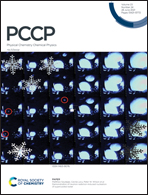Effect of atomic configuration and spin–orbit coupling on thermodynamic stability and electronic bandgap of monolayer 2H-Mo1−xWxS2 solid solutions†
Abstract
Through a combination of density functional theory calculations and cluster-expansion formalism, the effect of the configuration of the transition metal atoms and spin–orbit coupling on the thermodynamic stability and electronic bandgap of monolayer 2H-Mo1−xWxS2 is investigated. Our investigation reveals that, in spite of exhibiting a weak ordering tendency of Mo and W atoms at 0 K, monolayer 2H-Mo1−xWxS2 is thermodynamically stable as a single-phase random solid solution across the entire composition range at temperatures higher than 45 K. The spin–orbit coupling effect, induced mainly by W atoms, is found to have a minimal impact on the mixing thermodynamics of Mo and W atoms in monolayer 2H-Mo1−xWxS2; however, it significantly induces change in the electronic bandgap of the monolayer solid solution. We find that the band-gap energies of ordered and disordered solid solutions of monolayer 2H-Mo1−xWxS2 do not follow Vegard's law. In addition, the degree of the SOC-induced change in band-gap energy of monolayer 2H-Mo1−xWxS2 solid solutions not only depends on the Mo and W contents, but for a given alloy composition it is also affected by the configuration of the Mo and W atoms. This poses a challenge of fine-tuning the bandgap of monolayer 2H-Mo1−xWxS2 in practice just by varying the contents of Mo and W.



 Please wait while we load your content...
Please wait while we load your content...